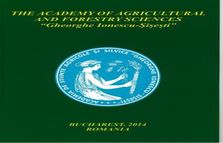
Over the time course, under the influence of social-economic transformations and the development of education, the organization of agronomic scientific research and academic life passed through various stages of institutional structuring process.
It is remarkable that the second half of the XIXth century and the beginning of the new century was the period which recorded the names of great forerunners in the process of agricultural education and research activity, like Ion Ionescu de la Brad, the author of the first handbook for agriculture and animal husbandry (1871), Petre S. Aurelian, Constantin Sandu-Aldea, Vlad Cârnu-Munteanu, G. Munteanu-Murgoci, Nicolae Filip, George Maior, C. Vasilescu, Carol Davila, Ion Athanasiu, Paul Riegler, Ioan Poienaru, Ioan Ştefan Furtună, V. Lucaci and others.
The first agricultural scientific institution in our country was founded in 1886 as the Central Agronomic Station, later on being included as a section of the Agricultural Research Institute of Romania in 1927.
The following scientific institution, the Institute of Veterinary Research – Pasteur was set up in 1895, and its perenniality and steady development can be followed within time, up to the present day.
The same year, the Zootechnical Institute is organized being attached to the Department of Animal Husbandry of the High School of Veterinary Medicine and in 1926, the National Zootehnical Institute is set up which in 1949 became the Institute for Zootechnical Research (IZR) having a network of several research stations (Bonţida, Pădureni, Runcu, Ruşeţu, Popăuţi, Palas, Dulbanu, Mărculeşti etc.).
Based on a systematic, unitary, visionary conception associated with resolute principles according to each practical branch of agriculture and agricultural science discipline, in 1927, the Agronomic Research Institute of Romania (A.R.I.R.) was built together with a network of experimental zonal stations by a High Royal Decree which stipulated its goals, responsibilities and patrimony.
According to the law, A.R.I.R. with its experimental stations located in different regions of the country had the task to develop applicative research activity in order to promote the progress of agriculture by guiding the farmers for cultivation of the new plant varieties, using new crop technologies including irrigation, fertilization and plant protection measures.
Another important moment in the history of Romanian agricultural research is represented by the setting up of the Academy of Agriculture in Romania on the occasion of the General Assembly of the National Society of Agriculture in May 1941 with the goal to contribute to the progress of scientific activity in the field of agriculture, in its broadest sense, and develop the research and accumulation of the necessary documentation in the benefit of the practical agriculture all over the country”.
In this way there was founded a forum of highest scientific and cultural level, which had to coordinate and transfer to the agricultural practice the new scientific agricultural knowledge for the progress of agriculture.